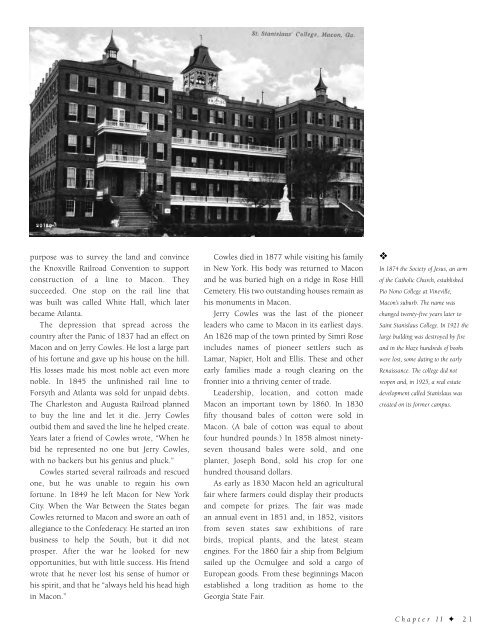Historic Macon
An illustrated history of the city of Macon, paired with the histories of companies, families and organizations that make the region great.
An illustrated history of the city of Macon, paired with the histories of companies, families and organizations that make the region great.
You also want an ePaper? Increase the reach of your titles
YUMPU automatically turns print PDFs into web optimized ePapers that Google loves.
purpose was to survey the land and convince<br />
the Knoxville Railroad Convention to support<br />
construction of a line to <strong>Macon</strong>. They<br />
succeeded. One stop on the rail line that<br />
was built was called White Hall, which later<br />
became Atlanta.<br />
The depression that spread across the<br />
country after the Panic of 1837 had an effect on<br />
<strong>Macon</strong> and on Jerry Cowles. He lost a large part<br />
of his fortune and gave up his house on the hill.<br />
His losses made his most noble act even more<br />
noble. In 1845 the unfinished rail line to<br />
Forsyth and Atlanta was sold for unpaid debts.<br />
The Charleston and Augusta Railroad planned<br />
to buy the line and let it die. Jerry Cowles<br />
outbid them and saved the line he helped create.<br />
Years later a friend of Cowles wrote, “When he<br />
bid he represented no one but Jerry Cowles,<br />
with no backers but his genius and pluck.”<br />
Cowles started several railroads and rescued<br />
one, but he was unable to regain his own<br />
fortune. In 1849 he left <strong>Macon</strong> for New York<br />
City. When the War Between the States began<br />
Cowles returned to <strong>Macon</strong> and swore an oath of<br />
allegiance to the Confederacy. He started an iron<br />
business to help the South, but it did not<br />
prosper. After the war he looked for new<br />
opportunities, but with little success. His friend<br />
wrote that he never lost his sense of humor or<br />
his spirit, and that he “always held his head high<br />
in <strong>Macon</strong>.”<br />
Cowles died in 1877 while visiting his family<br />
in New York. His body was returned to <strong>Macon</strong><br />
and he was buried high on a ridge in Rose Hill<br />
Cemetery. His two outstanding houses remain as<br />
his monuments in <strong>Macon</strong>.<br />
Jerry Cowles was the last of the pioneer<br />
leaders who came to <strong>Macon</strong> in its earliest days.<br />
An 1826 map of the town printed by Simri Rose<br />
includes names of pioneer settlers such as<br />
Lamar, Napier, Holt and Ellis. These and other<br />
early families made a rough clearing on the<br />
frontier into a thriving center of trade.<br />
Leadership, location, and cotton made<br />
<strong>Macon</strong> an important town by 1860. In 1830<br />
fifty thousand bales of cotton were sold in<br />
<strong>Macon</strong>. (A bale of cotton was equal to about<br />
four hundred pounds.) In 1858 almost ninetyseven<br />
thousand bales were sold, and one<br />
planter, Joseph Bond, sold his crop for one<br />
hundred thousand dollars.<br />
As early as 1830 <strong>Macon</strong> held an agricultural<br />
fair where farmers could display their products<br />
and compete for prizes. The fair was made<br />
an annual event in 1851 and, in 1852, visitors<br />
from seven states saw exhibitions of rare<br />
birds, tropical plants, and the latest steam<br />
engines. For the 1860 fair a ship from Belgium<br />
sailed up the Ocmulgee and sold a cargo of<br />
European goods. From these beginnings <strong>Macon</strong><br />
established a long tradition as home to the<br />
Georgia State Fair.<br />
❖<br />
In 1874 the Society of Jesus, an arm<br />
of the Catholic Church, established<br />
Pio Nono College at Vineville,<br />
<strong>Macon</strong>’s suburb. The name was<br />
changed twenty-five years later to<br />
Saint Stanislaus College. In 1921 the<br />
large building was destroyed by fire<br />
and in the blaze hundreds of books<br />
were lost, some dating to the early<br />
Renaissance. The college did not<br />
reopen and, in 1925, a real estate<br />
development called Stanislaus was<br />
created on its former campus.<br />
Chapter II ✦ 21
















